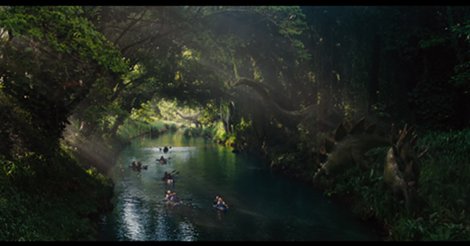
For the rest of July, we will be taking a look at the Jurassic Park films, mainly Jurassic Park and Jurassic World. We will be discussing the films in detail, so spoilers are possible but will be kept to a minimum.
Risks can be challenging to human perception. Some are obvious, like a 13-foot-tall carnivore with big, nasty, pointy teeth. Just about everyone in the Jurassic Park films appreciates the danger of claws and fangs, even if their safety mechanisms and procedures suggest otherwise (moats or ditches have been features of big cat enclosures for years). Some are not as visual, but still readily understood, like the venom of Dilophosaurus. And then some risks hide in plain sight.
Take the herbivores that inhabit these dinosaur parks. They roam with relative freedom compared to their meat-eating kin, and humans enter their habitats without concern. For example, in Jurassic World we see guests kayak down a river where apatosaurs and stegosaurs are drinking; they wear life vests but no protection from the 4 ton animal with the spiked tail just a few feet away! While these animals might not look at humans as food, they could easily injure or kill a human if they feel threatened or even by accident. Our local zoo has a peacock that roams freely, but I notice they still keep the elephants separate from the paying guests.
Unlike the oversights in carnivore containment, which serve a purpose to the plot, the risky nature of the herbivore habitats never comes back to bite anyone. We’re not meant to notice those risks, indeed we are probably meant not to notice them. That’s fine for films, which function like magic tricks, drawing our attention to the elements that advance the central themes so we don’t notice the styrofoam sets and computer-duplicated extras fleshing out the edges. But what about real life risks that can be just as hard to see?
I recently attended an academic conference where I encountered a risk that was new to me. For some participants, just being at the conference was a risk to their livelihood; indeed, several in attendance already faced a need to change jobs because of their religious views. This is a scenario many of us fear will happen to Christian professors or students at secular universities, and indeed some Christian organizations have faced challenges at those institutions. Yet in this case it was Christian professors at Christian universities; the conference in question was organized by BioLogos and the point of divergence is the evolutionary perspective on natural history.
To be fair, I was essentially getting one side of these situations. And as a matter of policy and religious freedom, I think these private universities should be able to set their own doctrinal positions. I also understand why so many have concerns about an evolutionary natural history and why it seems like embracing it risks slipping down a slope to apostasy. At the same time, I wonder about the cost to universities when challenging conversations are effectively moved off campus along with faculty who can speak to those conversations from a rigorously Christian worldview. Are we eliminating some of the connections that keep our networks balanced for optimal communication?
What risks are of greatest concern in your discipline or institution? What risks have been tacitly assumed that you would like to see reconsidered?
Andy has worn many hats in his life. He knows this is a dreadfully clichéd notion, but since it is also literally true he uses it anyway. Among his current metaphorical hats: husband of one wife, father of two teenagers, reader of science fiction and science fact, enthusiast of contemporary symphonic music, and chief science officer. Previous metaphorical hats include: comp bio postdoc, molecular biology grad student, InterVarsity chapter president (that one came with a literal hat), music store clerk, house painter, and mosquito trapper. Among his more unique literal hats: British bobby, captain’s hats (of varying levels of authenticity) of several specific vessels, a deerstalker from 221B Baker St, and a railroad engineer’s cap. His monthly Science in Review is drawn from his weekly Science Corner posts — Wednesdays, 8am (Eastern) on the Emerging Scholars Network Blog. His book Faith across the Multiverse is available from Hendrickson.

Leave a Reply